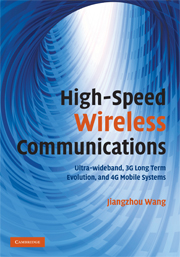Book contents
- Frontmatter
- Contents
- Preface
- Acknowledgements
- List of abbreviations
- Part I Introduction
- Part II UWB communications
- Part III Evolved 3G mobile communications
- Part IV 4G mobile communications
- 9 Optimal and MMSE detection for downlink OFCDM
- 10 Hybrid detection for OFCDM systems
- 11 Coded layered space-time-frequency architecture
- 12 Sub-packet transmission for hybrid ARQ systems
- Index
- References
12 - Sub-packet transmission for hybrid ARQ systems
from Part IV - 4G mobile communications
Published online by Cambridge University Press: 27 May 2010
- Frontmatter
- Contents
- Preface
- Acknowledgements
- List of abbreviations
- Part I Introduction
- Part II UWB communications
- Part III Evolved 3G mobile communications
- Part IV 4G mobile communications
- 9 Optimal and MMSE detection for downlink OFCDM
- 10 Hybrid detection for OFCDM systems
- 11 Coded layered space-time-frequency architecture
- 12 Sub-packet transmission for hybrid ARQ systems
- Index
- References
Summary
ARQ is a flexible and efficient technique for data transmissions. In hybrid ARQ, sub-packet schemes are more attractive for systems with burst errors than complete packet schemes. Although sub-packet schemes were proposed in ARQ systems, optimum sub-packet transmission is more effective to maximize throughput in a dynamic channel. Since convolutional codes are burst errors in decoding, the optimum sub-packet can be applied to convolutional codes. This chapter investigates the performance of sub-packet transmission for convolutionally coded systems. An efficient method is proposed to estimate the optimum number of sub-packets, and adaptive sub-packet schemes, i.e. schemes that enable a system to employ different optimum numbers of sub-packets under various conditions, are suggested to achieve maximum throughput in the system. Numerical and simulation results show that the adaptive sub-packet scheme is very effective for the convolutionally coded hybrid ARQ system, and it can provide higher throughput, smaller delay and lower dropping rate than complete packet schemes. Moreover, the adaptive sub-packet scheme can be flexibly used with packet combining techniques to further improve system throughput.
Introduction
In high-speed data communication systems, information sequences are transmitted usually in packets with fixed length. At a receiver, error correction and detection are carried out on the whole packet. If the packet is found in error, the receiver sends a request to the transmitter via a feedback channel, and then the whole packet is retransmitted. However, such a conventional complete-packet ARQ scheme is inefficient in the presence of burst errors.
- Type
- Chapter
- Information
- High-Speed Wireless CommunicationsUltra-wideband, 3G Long Term Evolution, and 4G Mobile Systems, pp. 296 - 312Publisher: Cambridge University PressPrint publication year: 2008



